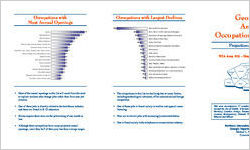Occupations with Most Annual Openings
Cashiers Retail Salespersons Child Care Workers Waiters & Waitresses Comb. Food Prep. & Serving Workers, Incl. Fast Food Preschool Teachers, Ex. Spec. Ed. Textile Wind., Tw ist., & Draw . Out Mach. Setrs., Opers., & Tndrs. Laborers & Freight, Stock, & Material Movers, Hand
Registered Nurses Stock Clerks & Order Fillers
Teacher Assistants Team Assemblers
General & Operations Managers Office Clerks, General
Elementary School Teachers, Ex. Spec. Ed. Truck Drivers, Heavy & Tractor-Trailer
140 120 100 90 80 70 70 60 60 60 60 60 50 50 40 40
Most of the annual openings in this list will result from the need to replace workers who change jobs rather than from new job creation.
One of these jobs is directly related to the healthcare industry and three are found in K-12 education.
Eleven require short-term on-the-job training of one month or less.
Although these occupations have many projected annual openings, more than half of them pay less than average wages.
Occupations with Largest Declines
-250
Sew ing Machine Operators
-90
Farm, Ranch, & Other Agricultural Managers
-80
Secretaries, Except Legal, Medical, & Executive
-70
Stock Clerks & Order Fillers
-60
Cooks, Fast Food
-50
Electrical & Electronic Equipment Assemblers
-40
Dishw ashers
-40
Order Clerks
-30
Butchers & Meat Cutters
-30
Insurance Claims & Policy Processing Clerks
-30
Meter Readers, Utilities
-30
Paper Goods Machine Setters, Operators, & Tenders
-30
Sw itchboard Operators, Incl. Answ ering Service
-20
Loan Interview ers & Clerks
-20
Maids & Housekeeping Cleaners
The occupations in this list are declining due to many factors, including technological advances, office automation and foreign competition.
One of these jobs is found mainly in textiles and apparel manufacturing.
Four are in clerical jobs with increasingly automated duties.
One is found mainly in the telephone communications industry.
Georgia Area
Occupational Trends
Projections to 2010
WIA Area #16 Heart of GA/Altamaha
This area encompasses 17 counties in the heart of the state in and around the city of Dublin. It includes the following counties: Appling, Bleckley, Candler, Dodge, Emanuel, Evans, Jeff Davis, Johnson, Laurens, Montgomery, Tattnall, Telfair, Toombs, Treutlen, Wayne, Wheeler and Wilcox.
Workforce Information & Analysis Division Georgia Department of Labor Michael L. Thurmond Commissioner
Total employment in WIA Area #16 is expected to reach almost 115,000 jobs by the year 2010, with more than 1,300 new jobs added each year. The area's economy is currently lagging behind both the state's and the nation's economy. Area job growth is expected to be 1.2 percent per year, while Georgia's job growth is expected to be 1.8 percent per year and the nation is expected to have annual job growth of 1.4 percent.
Area Highlights
This area is the home of the world-famous sweet Vidalia onion.
This area is also the home of a V. A. Hospital and several state prison facilities.
This area was the chief apparel products producer in Georgia during the period 1990 to 2000. As such, it was one of the hardest hit areas in the state with the transfer overseas of many apparel manufacturing jobs during the 10 year period.
Area population grew by only 12.8 percent over the ten years 1990 to 2000, among the smallest increases in the state. In contrast, Georgia's population grew at a rate of 25.8 percent over the same period.
Total personal income grew at a rate of 66.5 percent compared to a state rate of 98.2 percent.
For copies of the Georgia Career Planner, Georgia Occupational Trends in Brief
or this publication, call 404/232-3875 or contact your local
Department of Labor office.
Fastest Growing Occupations
Preschool Teachers, Ex. Spec. Ed.
Child Care Workers
Textile Wind., Tw ist., & Draw . Out Mach. Setrs., Opers., & Tndrs. Teacher Assistants
2.7%
Team Assemblers
1.8%
Registered Nurses Comb. Food Prep. & Serving Workers, Incl. Fast Food
1.7% 1.5%
General & Operations Managers
1.3%
Office Clerks, General
1.1%
Waiters & Waitresses Truck Drivers, Heavy & Tractor-Trailer
Retail Salespersons
1.1% 1.0% 0.8%
Laborers & Freight, Stock, & Material Movers, Hand 0.7%
Cashiers 0.5%
Elementary School Teachers, Ex. Spec. Ed. 0.3%
6.1%
10.0% 8.9%
Occupations with Largest Job Growth
Child Care Workers Preschool Teachers, Ex. Spec. Ed. Textile Wind., Tw ist., & Draw . Out Mach. Setrs., Opers., & Tndrs.
Teacher Assistants Team Assemblers Registered Nurses
Social & Human Service Assistants Home Health Aides
Correctional Officers & Jailers General & Operations Managers Textile Knitting & Weaving Mach. Setters, Operators, & Tenders Nursing Aides, Orderlies, & Attendants
Retail Salespersons Customer Service Representatives Truck Drivers, Heavy & Tractor-Trailer
780 630 510 370 330 280 280 260 240 230 230 210 200 190 190
These fast-growing occupations will have better employment prospects than occupations with slow or declining employment. Also, conditions will be more favorable for mobility and advancement.
One of the fastest growing occupations is associated with the healthcare industry and three are associated with K-12 education.
Eleven of these jobs do not require any formal education beyond high school.
These 15 occupations out of more than 700 - are projected to add about 5,000 jobs over the next 10 years, about 38 percent of all projected job growth in this area.
Eight occupations require short-term on-the-job training of one month or less and two require a bachelor's degree.
Nine of these occupations also appear in the chart of the fastest growing occupations.
Equal Opportunity Employer/Program Auxiliary Aids and Services Available upon Request to Individuals with Disabilities
